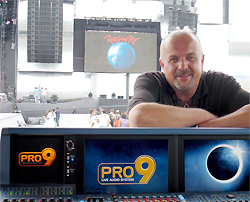Perhaps best known as the perennial front of house mixer for Tool, Alan “Big Nobby” Hopkinson spent most of 2011 on the road with System Of A Down. It was his first tour with the band, and his first behind a Midas digital mixing system – the PRO9.
“I’ve been a longstanding Midas user, but it’s always been an XL4 analog for me until now,” says Hopkinson. “I have used Midas digital previously though, as we have a PRO6 installed at Shepherd’s Bush Empire, probably the busiest 2,300-capacity theater in London. I have babysat many engineers on it there, and have seen many come in apprehensive and leave amazed. So I knew what I was getting into.”
With System Of A Down, Big Nobby used the PRO9 across Europe and North America, with occasional switches to a PRO6 as availability dictated. The most obvious difference from the XL4 was purely physical, with easier connectivity, remote routing, a much smaller footprint and lighter weight. The tour also carried the Klark Teknik DN9331 Rapide graphic EQ controller. “The Rapide is awesome,” he reports. “It lets me control the EQ on any channel or group. It’s great for delay towers and in-fills in large venues. Very easy to use, too.”
For dyed-in-the-wool analog engineers, the transition to digital is rarely fully satisfying. But such was not the case with the PRO9. “Look, I was dragged screaming into the digital domain. Frankly, I didn’t see the point when I already had exactly the sound I wanted,” Hopkinson explains. “The other digital consoles I’ve used couldn’t give me that. Poor sound, goes red in a heartbeat, and no balls at all. In my view, everyone got carried away with the digital movement, and people seemed to forget the main point: audio quality must be the prime objective.”
So he remained true to his roots, specifying Midas analog for his major tours over the past decade. “Look, there’s no denying that there are huge advantages to digital – in functionality, in flexibility, in footprint,” he continues. “But if you’re going to take on the XL4, you’d better have some serious currency to bring to the table, and the PRO Series does that. The sound is fat, with headroom for days and no overloading of the dreaded A/D converter. This is the first digital board that sounds as good as what it emulates. I can’t say fairer than that.”
With his desired sound quality now attainable in the digital domain, Hopkinson was free to explore and enjoy the many conveniences of the PRO Series architecture. “At Shepherd’s Bush, I loved Area B. When you’re babysitting, it lets you lend a hand without leaning over the engineer,” he states. “Out on tour, I used it a lot to start, but relied on it less as I got more familiar with all the options I had with POP Groups and VCA functions. I ‘m probably using the VCAs in a way POP Groups were designed for. Either way, I can pull up all the inputs and FX I need to address at once, so I don’t have to go searching through pages or layers.”
Another point of satisfaction was the PRO Series preamps and DSP effects. “Sonically, the inputs are pure Midas, and the processors sound great,” he reports. “I used the (Klark Teknik) DN780 reverb a lot; I have an analog version at home. But as an old analog guy, I must admit that I take certain comfort in having a couple of my favorite outboard units along for the ride. The fact that I can insert a Lexicon 480L into the PRO9 for old times’ sake, and it still sounds right, speaks volumes for the quality of the system.”
So while Alan Hopkinson – the engineer known as Big Nobby – remains an analog guy at heart, his experience with the PRO9 has convinced him that digital audio, done right, has been worth the wait. In fact, he’s using the PRO9 again as System Of A Down starts its 2012 world tour with February and March dates throughout Australia and New Zealand.




















